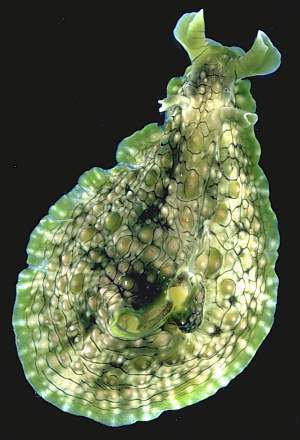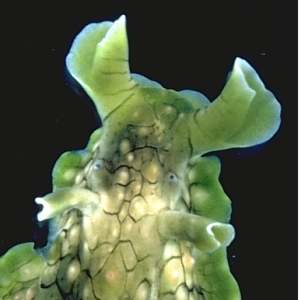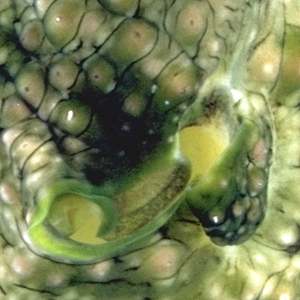
Dolabrifera brazieri
Sowerby, 1870
Order: ANASPIDEA
Superfamily: APLYSIOIDEA
Family: Aplysiidae
DISTRIBUTION
South-eastern Australia and northeastern New Zealand.
PHOTO
Two-Fold Bay, southern New South Wales, eastern Australia. March 1986 AM C149561. [animals ranged from 10-15cm long] Lower Left: showing head, Lower Right: showing opening into reduced mantle cavity. Photos: Bill Rudman
A large species of Dolabrifera often found intertidally in rock pools, and under rocks, where it lays a very recognisable egg mass, consisting of an aplysiid egg string, which instead of forming a typical aplysiid tangled mass, is attached as a flat ribbon arranged in a zigzag pattern [see photo]. It is hard and leathery to touch, with a relatively thick body wall. Although usually a mottled green, it is quite variable in colour, specimens ranging from a pale watery yellow to a dark purplish brown. Its colour provides it with very good camouflage, and it is often very difficult to see in the field. D. brazieri is a relatively large flattened Sea Hare in which the parapodia are fused to form a postero-dorsal cavity in which sits the mantle cavity. The only indication of the parapodia are the two small flaps in the posterior midline which form siphons directing an inhalent and exhalent water current in and out of the mantle cavity [lower right photo]. The body is covered in large conical tubercles which bear a white retractile branched filament at the tip [see photos in separate message]. The head [lower left photo] has the two pairs of enrolled tentacles, typical of all sea hares. The anterior pair, on either side of the mouth, are both chemosensory and tactile, being used both to 'smell' chemicals in the water, and to feel objects. The pair of tentacles behind the eyes, the rhinophores, are the main chemosensory organs, used for 'smelling' food and detecting noxious chemicals.
This large species of Dolabrifera, reaching about 15cm in length, differs from the tropical D. dolabrifera in its much larger size and the presence of the large smooth conical tubercles all over the body. It would appear to be endemic to New South Wales, in eastern Australia, and nearby waters.
See Dolabrifera shell page.
See Sea Hare shell page.
See photo of egg ribbon.
-
Allan, J. (1950) Australian Shells. Georgian House: Melbourne. 1-487.
-
Brook, F.J. (1998) The coastal molluscan fauna of the northern Kermadec Islands, southwest Pacific Ocean. Journal of the Royal Society of New Zealand 28: 185-233.
-
Hedley, C., (1917) Proceedings of the Linnean Society of New South Wales, 41: 717, Pl.49, fig. 25.
-
Sowerby, (1870) Proceedings of the Zoological Society of London, 1870: 250
-
Willan, R.C. & Morton, J.E. (1984) Cape Rodney to Okakari Point Marine Reserve. Marine Molluscs Part 2. Opisthobranchia. Leigh Marine Laboratory, University of Auckland, Auckland. 106 pages.


Rudman, W.B., 2003 (April 23) Dolabrifera brazieri Sowerby, 1870. [In] Sea Slug Forum. Australian Museum, Sydney. Available from http://www.seaslugforum.net/factsheet/dolabraz
Related messages
-
Re: Large tubercled ?Aplysia at Little Bay, Sydney
From: Kirsten Crosby, March 19, 2010 -
Sea slug? from Clovelly, Sydney
From: Eve Jary, March 18, 2010 -
Dolabrifera brazieri from Mooloolaba, QLD
From: Gary Cobb, August 28, 2008 -
Dolabrifera brazieri at Bateau Bay, New South Wales
From: Deb Gorgievski, August 22, 2008 -
Dolabrifera brazieri from eastern Victoria
From: John Eichler, February 7, 2007 -
Dolabrifera brazieri from New South Wales
From: Krista Rankmore, January 23, 2007 -
Dolabrifera brazieri with opaline gland secretions
From: Sascha Schulz, September 14, 2005 -
Dolabrifera brazieri from Victoria, Australia
From: John Eichler, May 13, 2005 -
Dolabrifera brazieri from New Zealand
From: Ross Armstrong, February 21, 2004 -
Dolabrifera brazieri from Lord Howe Island
From: W.B. Rudman, April 26, 2003 -
Dolabrifera brazieri from Lord Howe Island (2)
From: W.B. Rudman, April 26, 2003 -
Dolabrifera brazieri from Swansea, eastern Australia
From: Simon Voorwinde, April 26, 2003 -
Dolabella brazieri from northern New South Wales
From: Bill Rudman, April 26, 2003 -
Dolabella brazieri from southern New South Wales
From: Bill Rudman, April 26, 2003 -
Dolabrifera dolabrifera & D. brazieri
From: Bill Rudman, April 26, 2003
